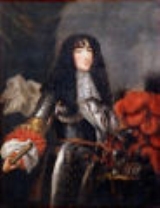
Descendants of Philippe I, Duke of Orléans
Encyclopedia

Philippe I, Duke of Orléans
Philippe of France was the youngest son of Louis XIII of France and his queen consort Anne of Austria. His older brother was the famous Louis XIV, le roi soleil. Styled Duke of Anjou from birth, Philippe became Duke of Orléans upon the death of his uncle Gaston, Duke of Orléans...
was the brother of Louis XIV of France
Louis XIV of France
Louis XIV , known as Louis the Great or the Sun King , was a Bourbon monarch who ruled as King of France and Navarre. His reign, from 1643 to his death in 1715, began at the age of four and lasted seventy-two years, three months, and eighteen days...
and the younger son of Louis XIII of France
Louis XIII of France
Louis XIII was a Bourbon monarch who ruled as King of France and of Navarre from 1610 to 1643.Louis was only eight years old when he succeeded his father. His mother, Marie de Medici, acted as regent during Louis' minority...
and Anne of Austria
Anne of Austria
Anne of Austria was Queen consort of France and Navarre, regent for her son, Louis XIV of France, and a Spanish Infanta by birth...
.
A Bourbon
House of Bourbon
The House of Bourbon is a European royal house, a branch of the Capetian dynasty . Bourbon kings first ruled Navarre and France in the 16th century. By the 18th century, members of the Bourbon dynasty also held thrones in Spain, Naples, Sicily, and Parma...
himself, he founded the third line of Dukes of Orléans descended patrilineally
Patrilineality
Patrilineality is a system in which one belongs to one's father's lineage. It generally involves the inheritance of property, names or titles through the male line as well....
from France's kings. His heirs constituted the senior cadet branch
Cadet branch
Cadet branch is a term in genealogy to describe the lineage of the descendants of the younger sons of a monarch or patriarch. In the ruling dynasties and noble families of much of Europe and Asia, the family's major assets – titles, realms, fiefs, property and income – have...
of the royal dynasty until the French Revolution
French Revolution
The French Revolution , sometimes distinguished as the 'Great French Revolution' , was a period of radical social and political upheaval in France and Europe. The absolute monarchy that had ruled France for centuries collapsed in three years...
(other sons of French kings failed to produce sons who could inherit their positions at court
Royal court
Royal court, as distinguished from a court of law, may refer to:* The Royal Court , Timbaland's production company*Court , the household and entourage of a monarch or other ruler, the princely court...
until after the Bourbon Restoration
Bourbon Restoration
The Bourbon Restoration is the name given to the period following the successive events of the French Revolution , the end of the First Republic , and then the forcible end of the First French Empire under Napoleon – when a coalition of European powers restored by arms the monarchy to the...
in the 19th century). They include the second duke
Philippe II, Duke of Orléans
Philippe d'Orléans was a member of the royal family of France and served as Regent of the Kingdom from 1715 to 1723. Born at his father's palace at Saint-Cloud, he was known from birth under the title of Duke of Chartres...
, who governed France during the minority of Louis XV in the Regency
Régence
The Régence is the period in French history between 1715 and 1723, when King Louis XV was a minor and the land was governed by a Regent, Philippe d'Orléans, the nephew of Louis XIV of France....
era; one French king, Louis Philippe
Louis Philippe
Louis Philippe may refer to:*Louis-Philippe I, King of the French, last King of France*Prince Philippe, Count of Paris, called King Louis Philippe II by some factions*Louis Philippe I, Duke of Orléans*Louis Philippe II, Duke of Orléans...
; and the Orléanist pretender
Pretender
A pretender is one who claims entitlement to an unavailable position of honour or rank. Most often it refers to a former monarch, or descendant thereof, whose throne is occupied or claimed by a rival, or has been abolished....
s to the throne of France still flourishing
Floruit
Floruit , abbreviated fl. , is a Latin verb meaning "flourished", denoting the period of time during which something was active...
in the 21st century. Accumulation of the vast wealth which the Orléans possessed and used to influence both politics and court life until it was confiscated
Confiscation
Confiscation, from the Latin confiscatio 'joining to the fiscus, i.e. transfer to the treasury' is a legal seizure without compensation by a government or other public authority...
during the French Revolution
French Revolution
The French Revolution , sometimes distinguished as the 'Great French Revolution' , was a period of radical social and political upheaval in France and Europe. The absolute monarchy that had ruled France for centuries collapsed in three years...
, began with Philippe, a life-long beneficiary of his brother's largesse.
He is often referred to historically as Philippe d'Anjou until 1660, when he was granted the dukedom of Orléans
Orléans
-Prehistory and Roman:Cenabum was a Gallic stronghold, one of the principal towns of the Carnutes tribe where the Druids held their annual assembly. It was conquered and destroyed by Julius Caesar in 52 BC, then rebuilt under the Roman Empire...
, the traditional appanage
Appanage
An apanage or appanage or is the grant of an estate, titles, offices, or other things of value to the younger male children of a sovereign, who would otherwise have no inheritance under the system of primogeniture...
conferred upon the second son of the French king whenever the title became available, as it did when Louis XIV's only paternal uncle, Gaston, Duke of Orléans
Gaston, Duke of Orléans
Gaston of France, , also known as Gaston d'Orléans, was the third son of King Henry IV of France and his wife Marie de Medici. As a son of the king, he was born a Fils de France. He later acquired the title Duke of Orléans, by which he was generally known during his adulthood...
, died.
In 1661 Philippe also received the dukedoms of Valois and Chartres
Duke of Chartres
Originally, the Duchy of Chartres was the comté de Chartres, an Earldom. The title of comte de Chartres thus became duc de Chartres. This duchy–peerage was given by Louis XIV of France to his nephew, Philippe II d'Orléans, at his birth in 1674...
. Following Philippe's victory in battle in 1671, Louis XIV added the dukedom of Nemours
Duke of Nemours
In the 12th and 13th centuries the Lordship of Nemours, in the Gatinais, France, was in possession of the house of Villebeon, a member of which, Gautier, was marshal of France in the middle of the 13th century...
, the marquis
Marquis
Marquis is a French and Scottish title of nobility. The English equivalent is Marquess, while in German, it is Markgraf.It may also refer to:Persons:...
ates of Coucy and Folembray, and the count
Count
A count or countess is an aristocratic nobleman in European countries. The word count came into English from the French comte, itself from Latin comes—in its accusative comitem—meaning "companion", and later "companion of the emperor, delegate of the emperor". The adjective form of the word is...
ships of Dourdan and Romorantin. As a son of a French king, Philippe ranked as a fils de France
Fils de France
Fils de France was the style and rank held by the sons of the kings and dauphins of France. A daughter was known as a fille de France .The children of the dauphin, who was the king's heir apparent, were accorded the same style and status as if they were the king's children instead of his...
, and as the king's eldest brother, he was invariably referred to at court simply as Monsieur
Monsieur
' is an honorific title that used to refer to or address the eldest living brother of the king in the French royal court. It is also a customary French title of respect and term of address for a French-speaking man, corresponding to such English titles as Mr...
.
Youth

At the death of Louis XIII in 1643, his elder brother succeeded to the throne as King Louis XIV. Philippe became the heir presumptive
Heir Presumptive
An heir presumptive or heiress presumptive is the person provisionally scheduled to inherit a throne, peerage, or other hereditary honour, but whose position can be displaced by the birth of an heir or heiress apparent or of a new heir presumptive with a better claim to the position in question...
, and remained so for almost twenty years, until the birth of his nephew Louis de France, in 1661. From then he became second in line of succession to the throne for another 20 years, until the Dauphin's eldest son was born. Philippe was commonly known as le Petit Monsieur, to distinguish him from his uncle, Gaston, who as the only brother of the previous monarch was known as le Grand Monsieur.
Character
In order to discourage the type of tempestuous relationship that had developed between Louis XIII and his younger brother Gaston, Anne of Austria and Cardinal Mazarin made it a private policy to prevent Philippe from pursuing ambitions which might prompt rivalry with or defiance of the king. Aside from his appanage, he was given no meaningful financial freedom from the Crown. Later, to his already rich holdings Philippe wanted to add the countship of Blois, with its château de ChambordChâteau de Chambord
The royal Château de Chambord at Chambord, Loir-et-Cher, France is one of the most recognizable châteaux in the world because of its very distinct French Renaissance architecture which blends traditional French medieval forms with classical Renaissance structures.The building, which was never...
, and the governorship of Languedoc
Languedoc
Languedoc is a former province of France, now continued in the modern-day régions of Languedoc-Roussillon and Midi-Pyrénées in the south of France, and whose capital city was Toulouse, now in Midi-Pyrénées. It had an area of approximately 42,700 km² .-Geographical Extent:The traditional...
, but both would be refused him by his brother.
During his youth, his behavior was closely watched by his mother and her advisor. Mindful that Gaston's treasonous habits had not only been evoked by the Fronde
Fronde
The Fronde was a civil war in France, occurring in the midst of the Franco-Spanish War, which had begun in 1635. The word fronde means sling, which Parisian mobs used to smash the windows of supporters of Cardinal Mazarin....
, but by his secret elopement with a foreign princess
Marguerite of Lorraine
Marguerite of Lorraine was a duchess of Orléans and Alençon. She was born in Nancy, Lorraine to Francis II, Duke of Lorraine, and Countess Christina of Salm. On 31 January 1632, she married Gaston, Duke of Orléans, son of Henry IV of France and Marie de' Medici...
which had left the royal brothers estranged for years, Philippe's inclination toward homosexuality
Homosexuality
Homosexuality is romantic or sexual attraction or behavior between members of the same sex or gender. As a sexual orientation, homosexuality refers to "an enduring pattern of or disposition to experience sexual, affectional, or romantic attractions" primarily or exclusively to people of the same...
was not discouraged. Reportedly, Cardinal Mazarin even arranged for the de-flowering
Virginity
Virginity refers to the state of a person who has never engaged in sexual intercourse. There are cultural and religious traditions which place special value and significance on this state, especially in the case of unmarried females, associated with notions of personal purity, honor and worth...
of Philippe at the hands of his own nephew, Philip Julian Mancini
Philip Julian Mancini
Philippe Jules Mancini , Duke of Nevers, was the nephew of Cardinal Mazarin, chief minister of France immediately after the death of King Louis XIII...
. Queen Anne discouraged Philippe from traditional manly pursuits such as soldiering
Armed forces
The armed forces of a country are its government-sponsored defense, fighting forces, and organizations. They exist to further the foreign and domestic policies of their governing body, and to defend that body and the nation it represents from external aggressors. In some countries paramilitary...
and politics, and encouraged him to wear dresses, makeup, and to exhibit effeminate
Effeminacy
Effeminacy describes traits in a human male, that are more often associated with traditional feminine nature, behaviour, mannerisms, style or gender roles rather than masculine nature, behaviour, mannerisms, style or roles....
behaviour. As an adult, he continued to enjoy wearing feminine clothing and fragrances.
Even once married, he reportedly carried on open romantic affairs with German nobles, with no regard to either of his two wives. Philippe's mignon
Mignon
Mignon is an opéra comique in three acts by Ambroise Thomas. The original French libretto was by Jules Barbier and Michel Carré, based on Goethe's novel Wilhelm Meisters Lehrjahre. The Italian version was translated by Giuseppe Zaffira. The opera is mentioned in James Joyce's The Dead,...
s, invariably younger, handsome men, would dominate contemporary and historical commentaries about his role at court. Among them one man stands out, Philip of Lorraine-Armagnac
House of Guise
The House of Guise was a French ducal family, partly responsible for the French Wars of Religion.The Guises were Catholic, and Henry Guise wanted to end growing Calvinist influence...
, the chevalier de Lorraine, who has been described as "insinuating, brutal and devoid of scruple". According to Dirk van der Cruysse, the chevalier
...was also the worst enemy of the latter's two wives. As greedy as a vulture, this cadet of the French branch of the House of LorraineDukes of Lorraine family treeThis is a family tree of the House of Lorraine. It ranges from the foundation of the Longwy dynasty, in 1047, to the abdication of Francis III of Lorraine in 1737.See also: Lorraine...
had, by the end of the 1650s, hooked Monsieur like a harpooned whale. The young prince loved him with a passion that worried Madame Henrietta and the court bishop, Cosnac, but it was plain to the King that, thanks to the attractive face and sharp mind of the good-looking cavalier, he would have his way with his brother.
In January 1670, Philippe's wife had prevailed upon the King to imprison the chevalier
Chevalier de Lorraine
Philippe of Lorraine, called the Chevalier de Lorraine was a French noble man and member of the House of Guise, cadet of the Ducal house of Lorraine. He was the renowned lover of Philippe de France, Monsieur, brother of Louis XIV.-Biography:Philippe de Lorraine was the second son of the Count and...
, first near Lyon
Lyon
Lyon , is a city in east-central France in the Rhône-Alpes region, situated between Paris and Marseille. Lyon is located at from Paris, from Marseille, from Geneva, from Turin, and from Barcelona. The residents of the city are called Lyonnais....
, then in the Mediterranean island-fortress of château d'If
Château d'If
The Château d'If is a fortress located on the island of If, the smallest island in the Frioul Archipelago situated in the Mediterranean Sea about a mile offshore in the Bay of Marseille in southeastern France...
. Finally, he was banished to Rome
Rome
Rome is the capital of Italy and the country's largest and most populated city and comune, with over 2.7 million residents in . The city is located in the central-western portion of the Italian Peninsula, on the Tiber River within the Lazio region of Italy.Rome's history spans two and a half...
. However, by February, the Duke of Orléans' protests and pleas persuaded the King to restore him to his brother's entourage.
Military career
Monsieur was not given significant responsibility. Despite this, he proved to be an exceptionally brave and competent commanderCommander
Commander is a naval rank which is also sometimes used as a military title depending on the individual customs of a given military service. Commander is also used as a rank or title in some organizations outside of the armed forces, particularly in police and law enforcement.-Commander as a naval...
in the field. He fought with distinction in the 1667 promenade militaire against Flanders during the War of Devolution
War of Devolution
The War of Devolution saw Louis XIV's French armies overrun the Habsburg-controlled Spanish Netherlands and the Franche-Comté, but forced to give most of it back by a Triple Alliance of England, Sweden, and the Dutch Republic in the Treaty of Aix-la-Chapelle.-Background:Louis's claims to the...
(hastening back to his life at court, however, immediately after victory was assured).
Philippe resumed military command in 1672. In 1677, he won a great victory against William of Orange
William III of England
William III & II was a sovereign Prince of Orange of the House of Orange-Nassau by birth. From 1672 he governed as Stadtholder William III of Orange over Holland, Zeeland, Utrecht, Guelders, and Overijssel of the Dutch Republic. From 1689 he reigned as William III over England and Ireland...
at the Battle of Cassel
Battle of Cassel (1677)
The Battle of Cassel was fought on April 11, 1677, as a part of the Franco-Dutch War. It resulted in a French victory under Philippe I, Duke of Orléans, assisted by the Duke of Humières and Marshal Luxembourg, against the Dutch under William III of Orange, Stadtholder of the Netherlands...
in northern France
France
The French Republic , The French Republic , The French Republic , (commonly known as France , is a unitary semi-presidential republic in Western Europe with several overseas territories and islands located on other continents and in the Indian, Pacific, and Atlantic oceans. Metropolitan France...
and tookSaint-Omer
Saint-Omer
Saint-Omer , a commune and sub-prefecture of the Pas-de-Calais department west-northwest of Lille on the railway to Calais. The town is named after Saint Audomar, who brought Christianity to the area....
. Reportedly, Louis XIV was jealous of his brother's success and, as result, Philippe was never again given command of an army. However, he was publicly acknowledged by Louis for his achievements.
At court
Madame de Maintenon, the King's morganaticMorganatic marriage
In the context of European royalty, a morganatic marriage is a marriage between people of unequal social rank, which prevents the passage of the husband's titles and privileges to the wife and any children born of the marriage...
wife, despised by Monsieur almost as much as by his garrulous wife, Madame (the Princess Palatine "Liselotte", was determined that her former charges, the King's legitimised children by Madame de Montespan
Françoise-Athénaïs, marquise de Montespan
Françoise Athénaïs de Rochechouart de Mortemart, marquise of Montespan , better known as Madame de Montespan, was the most celebrated maîtresse en titre of King Louis XIV of France, by whom she had seven children....
, would efface their bastardy
Legitimacy (law)
At common law, legitimacy is the status of a child who is born to parents who are legally married to one another; and of a child who is born shortly after the parents' divorce. In canon and in civil law, the offspring of putative marriages have been considered legitimate children...
by contracting dynastic marital alliances. To overcome Monsieur and Madames revulsion upon the King's insistence on marrying the youngest of these legitimised "princesses", Françoise-Marie de Bourbon
Françoise-Marie de Bourbon
Françoise Marie de Bourbon, Légitimée de France was the youngest legitimised daughter of Louis XIV of France and his maîtresse-en-titre, Françoise-Athénaïs, marquise de Montespan. Originally known as the second Mademoiselle de Blois, that style eventually gave way to the name Françoise Marie de...
, to their son and heir, Philippe, Duke of Chartres
Philippe II, Duke of Orléans
Philippe d'Orléans was a member of the royal family of France and served as Regent of the Kingdom from 1715 to 1723. Born at his father's palace at Saint-Cloud, he was known from birth under the title of Duke of Chartres...
in 1692, Louis enriched the bride with a dowry
Dowry
A dowry is the money, goods, or estate that a woman brings forth to the marriage. It contrasts with bride price, which is paid to the bride's parents, and dower, which is property settled on the bride herself by the groom at the time of marriage. The same culture may simultaneously practice both...
of two million livres and gave his brother the Palais Royal
Palais Royal
The Palais-Royal, originally called the Palais-Cardinal, is a palace and an associated garden located in the 1st arrondissement of Paris...
, which became the Paris residence of the Dukes of Orléans until 1793.
In 1693, Philippe's wealthy cousin, Anne Marie Louise, Duchess of Montpensier, la grande Mademoiselle died, and left him most of her wealth. This brought him the dukedoms of Montpensier, Châtellerault
Châtellerault
Châtellerault is a commune in the Vienne department in the Poitou-Charentes region in France.It is located to the north of Poitou, and the residents are called Châtelleraudais.-Geography:...
and Saint-Fargeau
Saint-Fargeau
Saint-Fargeau is a commune in the Yonne department in Burgundy in north-central France.-Personalities:*In the early years of the reign of Louis XIV, the château was the home to his exiled cousin, the wealthy Anne Marie Louise d'Orléans. She lived in the château of the town, giving the building its...
, as well as the princedom of Joinville, the marquisate of Mézières and the barony of Beaujolais
Beaujolais
Beaujolais is a French Appellation d'Origine Contrôlée wine generally made of the Gamay grape which has a thin skin and is low in tannins. Like most AOC wines they are not labeled varietally. Whites from the region, which make up only 1% of its production, are made mostly with Chardonnay grapes...
.
Philippe also received an allowance for his expenses at court which, prudently invested, augmented his fortune.
Death
On the evening of 8 June 1701, Monsieur and the King had a terrible argument about the Duke of Chartres' neglect of his wife, in apparent response to never receiving the charges the King had promised him upon his marriage with Mademoiselle de Blois. Philippe pleaded his son's case with such vehemence that a footmanFootman
A footman is a male servant, notably as domestic staff.-Word history:The name derives from the attendants who ran beside or behind the carriages of aristocrats, many of whom were chosen for their physical attributes. They ran alongside the coach to make sure it was not overturned by such obstacles...
felt obliged to enter the King's chamber to warn the royal brothers that their quarrel was being overheard by the entire court.
After dinner, Philippe went home to Saint-Cloud. That night, he suffered a stroke
Stroke
A stroke, previously known medically as a cerebrovascular accident , is the rapidly developing loss of brain function due to disturbance in the blood supply to the brain. This can be due to ischemia caused by blockage , or a hemorrhage...
and fell into a coma
Coma
In medicine, a coma is a state of unconsciousness, lasting more than 6 hours in which a person cannot be awakened, fails to respond normally to painful stimuli, light or sound, lacks a normal sleep-wake cycle and does not initiate voluntary actions. A person in a state of coma is described as...
. He died at his château de Saint-Cloud on 9 June 1701. The King's former mistress, Madame de Montespan, was said to have wept bitterly at the loss of her one remaining friend. His wife (whom he eventually befriended, though never loved) also mourned deeply, as did his granddaughter, the Duchess of Bourgogne, along with his brother, the King.
Henrietta Anne and Philippe : Relationship Background
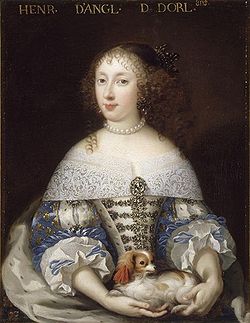
Princess
Princess is the feminine form of prince . Most often, the term has been used for the consort of a prince, or his daughters....
Henrietta of England, daughter of King Charles I of England
Charles I of England
Charles I was King of England, King of Scotland, and King of Ireland from 27 March 1625 until his execution in 1649. Charles engaged in a struggle for power with the Parliament of England, attempting to obtain royal revenue whilst Parliament sought to curb his Royal prerogative which Charles...
, in the chapel of the Palais-Royal in Paris. Both were grandchildren of Henry IV of France
Henry IV of France
Henry IV , Henri-Quatre, was King of France from 1589 to 1610 and King of Navarre from 1572 to 1610. He was the first monarch of the Bourbon branch of the Capetian dynasty in France....
and Marie de' Medici
Marie de' Medici
Marie de Médicis , Italian Maria de' Medici, was queen consort of France, as the second wife of King Henry IV of France, of the House of Bourbon. She herself was a member of the wealthy and powerful House of Medici...
. She was known at court as Madame
Fils de France
Fils de France was the style and rank held by the sons of the kings and dauphins of France. A daughter was known as a fille de France .The children of the dauphin, who was the king's heir apparent, were accorded the same style and status as if they were the king's children instead of his...
, Henriette d'Angleterre (Henrietta of England) or affectionately as Minette.
Philippe and Henriette remained indifferent to one another and went on to seek comfort from others. Philippe openly paraded his mignons
Les Mignons
Les Mignons was a term used by polemicists in the toxic atmosphere of the French Wars of Religion and taken up by the people of Paris, to designate the favourites of Henry III of France, from his return from Poland to reign in France in 1574, to his assassination in 1589, a disastrous end to which...
in front of his wife and the whole court. Among them were Armand de Gramont, Count of Guiche
Armand de Gramont, comte de Guiche
Armand de Gramont, Comte de Guiche was a French nobleman, adventurer, and one of the greatest playboys of the 17th century....
, known for his arrogance and good looks, the marquis de Châtillon, and his first lover Philip Julian Mancini
Philip Julian Mancini
Philippe Jules Mancini , Duke of Nevers, was the nephew of Cardinal Mazarin, chief minister of France immediately after the death of King Louis XIII...
. Meanwhile, Henriette proved to be very popular at court as a pretty, good-natured princess, much to Philippe's annoyance.
She soon attracted the attention of the King. In order to hide this attraction from the King's mother and wife, Henriette and Louis invented the story that he was constantly in Henriette's company in order to be close to one of her ladies-in-waiting, Louise de La Vallière
Louise de La Vallière
Louise de La Vallière was a mistress of Louis XIV of France from 1661 to 1667. She later became the Duchess of La Vallière and Duchess of Vaujours in her own right...
. In time, Louis indeed fell in love with Louise and made her his mistress.
Reluctantly, and somewhat bitterly, Henriette stepped aside. She is said to have eventually taken one of her husband's earlier conquests, Armand de Gramont as a lover. This caused all sorts of arguments at the Palais Royal, where the Orléans lived. Despite this marital dissension, several children were born of their union. However, Henriette, known for her fragile and delicate health, had four miscarriages in the space of five years. By the time of the birth of Anne Marie
Anne Marie of Orléans
Anne Marie d'Orléans was the first Queen consort of Sardinia and the maternal grandmother of Louis XV of France...
, the couple was notorious for the frequency of their quarrels at court and at home in the Palais-Royal.
By the time of the birth of Anne Marie, the couple was notorious for the frequency of their quarrels at court and at home in the Palais-Royal. After joining his brother Louis, the Queen, Mademoiselle , Madame de Montespan
Françoise-Athénaïs, marquise de Montespan
Françoise Athénaïs de Rochechouart de Mortemart, marquise of Montespan , better known as Madame de Montespan, was the most celebrated maîtresse en titre of King Louis XIV of France, by whom she had seven children....
and Louise de La Vallière
Louise de La Vallière
Louise de La Vallière was a mistress of Louis XIV of France from 1661 to 1667. She later became the Duchess of La Vallière and Duchess of Vaujours in her own right...
at a military campaign in northern France, the ducal couple returned to Saint-Cloud. It was there that the Duchess died at the age of twenty-six.
The death of the duchess on 30 June 1670 was popularly attributed to poison. The main suspects of this alleged crime were the Duke himself and the Chevalier de Lorraine
Chevalier de Lorraine
Philippe of Lorraine, called the Chevalier de Lorraine was a French noble man and member of the House of Guise, cadet of the Ducal house of Lorraine. He was the renowned lover of Philippe de France, Monsieur, brother of Louis XIV.-Biography:Philippe de Lorraine was the second son of the Count and...
. Although the duke may not have been involved, the enmity between Minette and the Chevalier de Lorraine was not a hidden truth. After an autopsy was performed, it was reported that Henrietta-Anne had died of peritonitis
Peritonitis
Peritonitis is an inflammation of the peritoneum, the serous membrane that lines part of the abdominal cavity and viscera. Peritonitis may be localised or generalised, and may result from infection or from a non-infectious process.-Abdominal pain and tenderness:The main manifestations of...
caused by an ulcer. During his marriage to Henriette-Anne, Philippe was heard to have said that he had loved her for fifteen days.
Children
| # | Name of Descendant | Portrait | Birth | Death | Relations | Marriages | Issue |
|---|---|---|---|---|---|---|---|
| 1 | Marie Louise d'Orléans |  |
March 26, 1662 | February 12, 1689 | |
Charles II of Spain Charles II of Spain Charles II was the last Habsburg King of Spain and the ruler of large parts of Italy, the Spanish territories in the Southern Low Countries, and Spain's overseas Empire, stretching from the Americas to the Spanish East Indies... |
|
| 2 | Anne Marie d'Orléans | August 27, 1669 | August 26, 1728 | |
Victor Amadeus II of Sardinia Victor Amadeus II of Sardinia Victor Amadeus II was Duke of Savoy from 1675 to 1730. He also held the titles of marquis of Saluzzo, duke of Montferrat, prince of Piedmont, count of Aosta, Moriana and Nizza. Louis XIV organised his marriage in order to maintain French influence in the Duchy but Victor Amadeus soon broke away... |
|
Grandchildren
| # | Name of Descendant | Portrait | Birth | Death | Relations | Marriage | Issue |
|---|---|---|---|---|---|---|---|
| 1 | Maria Adelaide of Savoy |  |
December 6, 1685 | February 12, 1712 | and Victor Amadeus II of Sardinia Granddaughter of Philippe de France and Henrietta of England |
Louis, Dauphin of France |
|
| 2 | Maria Luisa Gabriella of Savoy Maria Luisa of Savoy Maria Luisa of Savoy was a Savoyard princess and the first wife of Philip V of Spain. She acted as Regent of Spain and had great influence over her husband... |
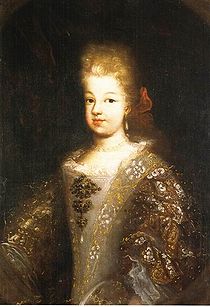 |
August 17, 1688 | February 14, 1714 | and Victor Amadeus II of Sardinia Granddaughter of Philippe de France and Henrietta of England |
Philip V of Spain Philip V of Spain Philip V was King of Spain from 15 November 1700 to 15 January 1724, when he abdicated in favor of his son Louis, and from 6 September 1724, when he assumed the throne again upon his son's death, to his death.Before his reign, Philip occupied an exalted place in the royal family of France as a... |
|
| 3 | Charles Emmanuel III of Sardinia Charles Emmanuel III of Sardinia Charles Emmanuel III was the Duke of Savoy and King of Sardinia from 1730 until his death.-Biography:... |
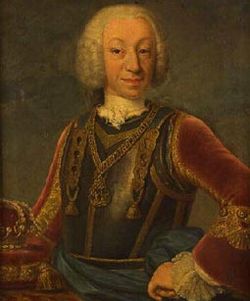 |
April 27, 1701 | February 20, 1773 | and Victor Amadeus II of Sardinia Grandson of Philippe de France and Henrietta of England |
(1) Anne Christine Louise of Bavaria Anne Christine Louise of Bavaria Anne Christine of Sulzbach , also called Anne of the Palatinate, was a princess of the Bavarian Circle of the Holy Roman Empire and first wife of Charles Emmanuel, Prince of Piedmont. She died as a result of giving birth.-Biography:Anne Christine was born a Countess Palatine of Sulzbach... (2) Polyxena Christina of Hesse-Rotenburg Polyxena Christina of Hesse-Rotenburg Princess Polyxena of Hesse-Rheinfels-Rotenburg was the second wife of Charles Emmanuel, Prince of Piedmont whom she married in 1724... (3) Elisabeth Therese of Lorraine |
|
Great-grandchildren
| # | Name of Descendant | Portrait /Coat of Arms | Birth | Death | Relations | Marriages | Issue |
|---|---|---|---|---|---|---|---|
| 1 | Louis XV of France Louis XV of France Louis XV was a Bourbon monarch who ruled as King of France and of Navarre from 1 September 1715 until his death. He succeeded his great-grandfather at the age of five, his first cousin Philippe II, Duke of Orléans, served as Regent of the kingdom until Louis's majority in 1723... |
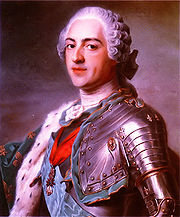 |
15 February 1710 | 10 May 1774 | and Marie-Adélaïde of Savoy Grandson of Anne Marie d'Orléans and Victor Amadeus II of Sardinia Great-Grandson of Philippe de France and Henrietta of England |
Marie Leszczyńska |
|
| 2 | Louis I of Spain | 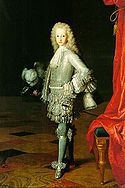 |
August 25, 1707 | August 31, 1724 | and Philip V of Spain Grandson of Anne Marie d'Orléans and Victor Amadeus II of Sardinia Great-Grandson of Philippe de France and Henrietta of England |
Louise Élisabeth d'Orléans |
|
| 3 | Ferdinand VI of Spain Ferdinand VI of Spain Ferdinand VI , called the Learnt, was King of Spain from 9 July 1746 until his death. He was the fourth son of the previous monarch Philip V and his first wife Maria Luisa of Savoy... |
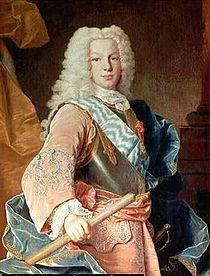 |
September 23, 1713 | August 10, 1759 | and Philip V of Spain Grandson of Anne Marie d'Orléans and Victor Amadeus II of Sardinia Great-Grandson of Philippe de France and Henrietta of England |
Barbara of Portugal Barbara of Portugal Barbara of Portugal was an Infanta of Portugal and later Queen of Spain as wife of Ferdinand VI of Spain.-Life in Portugal:... |
|
| 4 | Victor Amadeus III of Savoy | 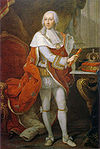 |
June 26, 1726 | October 16, 1796 | and Polyxena Christina of Hesse-Rotenburg Grandson of Anne Marie d'Orléans and Victor Amadeus II of Sardinia Great-Grandson of Philippe de France and Henrietta of England |
Maria Antonietta of Spain Maria Antonietta of Spain Maria Antonia Ferdinanda of Spain was an Infanta of Spain and the youngest daughter of Philip V of Spain and Elisabeth Farnese. She was the wife of Victor Amadeus III of Sardinia whom she married in 1750... |
|
| 5 | Eleonora Maria Teresa of Savoy Princess Eleonora of Savoy Eleonora of Savoy was a Savoyard princess, the eldest daughter of Charles Emmanuel III of Sardinia and his second wife Polyxena of Hesse-Rotenburg... |
1728 | 1781 | and Polyxena Christina of Hesse-Rotenburg Granddaughter of Anne Marie d'Orléans and Victor Amadeus II of Sardinia Great-Granddaughter of Philippe de France and Henrietta of England |
|
|
|
| 6 | Maria Luisa Gabriella of Savoy Princess Maria Luisa of Savoy (1729–1767) Maria Luisa of Savoy was a princess of Savoy. A religious woman, she died unmarried.-Biography:... |
1729 | 1767 | and Polyxena Christina of Hesse-Rotenburg Granddaughter of Anne Marie d'Orléans and Victor Amadeus II of Sardinia Great-Granddaughter of 'Philippe de France and Henrietta of England |
a nun |
|
|
| 7 | Maria Felicita Princess Maria Felicita of Savoy Maria Felicita of Savoy was ) a princess of the house of Savoy, the third daughter of Charles Emmanuel III of Sardinia and his second wife Polyxena of Hesse-Rotenburg... |
1730 | 1801 | and Polyxena Christina of Hesse-Rotenburg Granddaughter of Anne Marie d'Orléans and Victor Amadeus II of Sardinia Great-Granddaughter of Philippe de France and Henrietta of England |
|
|
|
| 8 | Benedetto Maria Maurizio of Savoy Benedetto, Duke of Chablais Benedetto of Savoy was a prince of Savoy and Duke of Chablais. He was born in the reign of his father Charles Emmanuel III, King of Sardinia. He has no descendants but had a distinguished military career... (Duke of Chablais and Marchese of Ivrea) |
1741 | 1808 | and Elisabeth Teresa of Lorraine Grandson of Anne Marie d'Orléans and Victor Amadeus II of Sardinia Great-Grandson of Philippe de France and Henrietta of England |
his niece Maria Ana Princess Maria Ana of Savoy Maria Anna of Savoy was a Princess of Savoy by birth and was the Duchess of Chablais by marriage.-Biography:... |
|
Further Descent
| # | Name of Descendant | Portrait | Birth | Death | Relations | Marriages | Issue |
|---|---|---|---|---|---|---|---|
| 1 | Louise Élisabeth, Duchess of Parma Princess Louise Élisabeth of France Louise Élisabeth de France was the eldest daughter of King Louis XV of France and his Queen consort, Maria Leszczyńska, and the elder twin sister of Anne Henriette de France. As the daughter of the king, she was a Daughter of France... |
 |
August 14, 1727 | December 6, 1759 | and Maria Leszczyńska |
Philip, Duke of Parma Philip, Duke of Parma Philip of Spain was Duke of Parma from 1748 to 1765. He founded the House of Bourbon-Parma , a cadet line of the Spanish branch of the dynasty... |
|
| 2 | Isabella of Parma |  |
31 December 1741 | November 27, 1763 | and Philip, Duke of Parma |
Joseph II, Holy Roman Emperor Joseph II, Holy Roman Emperor Joseph II was Holy Roman Emperor from 1765 to 1790 and ruler of the Habsburg lands from 1780 to 1790. He was the eldest son of Empress Maria Theresa and her husband, Francis I... |
|
| 3 | Maria Theresia | 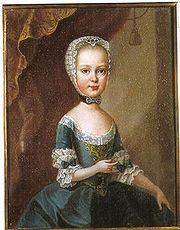 |
March 20, 1762 | January 23, 1770 | Joseph II, Holy Roman Emperor |
|
|
| 4 | Ferdinand, Duke of Parma Ferdinand, Duke of Parma Ferdinand Maria Philip Louis Sebastian Francis James of Parma was Duke of Parma from 1765 to 1802. He was the second child and only son of Philip, Duke of Parma and Princess Louise-Élisabeth of France, eldest daughter of Louis XV of France and Maria Leszczyńska... |
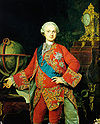 |
January 20, 1751 | October 9, 1802 | and Philip, Duke of Parma |
Archduchess Maria Amalia of Austria |
|
| 5 | Princess Caroline of Parma Princess Caroline of Parma Carolina of Parma was a Princess of Parma by birth, and Princess of Saxony by marriage to Prince Maximilian of Saxony. Carolina was the eldest child of Ferdinand, Duke of Parma and his wife Archduchess Maria Amalia of Austria.-Family:Her full baptismal name was Carolina Maria Teresa Giuseppa... |
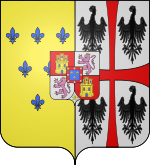 |
November 22, 1770 | March 1, 1804 | and Archduchess Maria Amalia of Austria. |
Prince Maximilian of Saxony |
|
| 6 | Louis of Etruria Louis of Etruria Louis was the first of only two Kings of Etruria.Louis was the son of Ferdinand, Duke of Parma and Maria Amalia of Austria, the second surviving daughter of Maria Theresa of Austria and Francis I, Holy Roman Emperor.... |
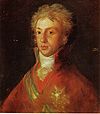 |
5 July 1773 | 27 May 1803 | and Archduchess Maria Amalia of Austria. |
Maria Louisa, Duchess of Lucca |
|
| 7 | Maria Antonia |  |
28 November 1774 | 20 February 1841 | and Archduchess Marie Amalie of Austria. |
a nun |
|
| 8 | Charlotte of Parma |  |
September 7, 1777 | 1812 | and Archduchess Maria Amalia of Austria. |
a nun |
|
| 9 | Maria Luisa of Parma Maria Luisa of Parma Maria Luisa of Parma was Queen consort of Spain from 1788 to 1808 as the wife of King Charles IV of Spain. She was the youngest daughter of Duke Philip of Parma and his wife, Louise-Élisabeth of France, the eldest daughter of King Louis XV.She was christened Luisa Maria Teresa Ana, but was known... |
 |
December 9, 1751 | January 2, 1819 | and Philip, Duke of Parma |
Charles IV of Spain Charles IV of Spain Charles IV was King of Spain from 14 December 1788 until his abdication on 19 March 1808.-Early life:... |
|
| 10 | Carlota Joaquina of Spain |  |
25 April 1775 | 7 January 1830 | and Charles IV of Spain |
John VI of Portugal John VI of Portugal John VI John VI John VI (full name: João Maria José Francisco Xavier de Paula Luís António Domingos Rafael; (13 May 1767 – 10 March 1826) was King of the United Kingdom of Portugal, Brazil and the Algarves (later changed to just King of Portugal and the Algarves, after Brazil was recognized... |
|
| 11 | Maria Amalia |  |
January 9, 1779 | July 22, 1798 | and Charles IV of Spain |
|
|
| 12 | Maria Louisa Maria Louisa of Spain, Duchess of Lucca Maria Luisa of Spain was an Infanta of Spain. She was a daughter of King Carlos IV of Spain and his wife Maria Luisa of Parma. In 1795, age thirteen, she married her first cousin Louis, Hereditary Prince of Parma... |
 |
July 6, 1782 | March 13, 1824 | and Charles IV of Spain |
Louis of Etruria Louis of Etruria Louis was the first of only two Kings of Etruria.Louis was the son of Ferdinand, Duke of Parma and Maria Amalia of Austria, the second surviving daughter of Maria Theresa of Austria and Francis I, Holy Roman Emperor.... |
|
| 13 | Ferdinand VII of Spain | 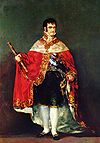 |
October 14, 1784 | September 29, 1833 | and Charles IV of Spain |
(1) Maria Antonia of Naples (2) Maria Isabel of Portugal Maria Isabel of Portugal Maria Isabel of Portugal was an Infanta of Portugal and was later the Queen of Spain as the second wife of Ferdinand VII of Spain.-Biography:... (3) Maria Josepha of Saxony Maria Josepha of Saxony Maria Josepha of Saxony was Queen consort of Spain as the wife of King Ferdinand VII of Spain... (4) Maria Christina of the Two Sicilies Maria Christina of the Two Sicilies Maria Christina of the Two Sicilies was Queen consort of Spain and Regent of Spain .-Early years and first marriage:... |
|
| 14 | Charles, Count of Molina Infante Carlos, Count of Molina The Infante Carlos of Spain was the second surviving son of King Charles IV of Spain and of his wife, Maria Luisa of Parma. As Carlos V he was the first of the Carlist claimants to the throne of Spain... |
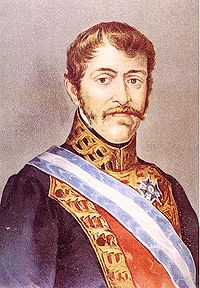 |
March 29, 1788 | March 10, 1855 | and Charles IV of Spain |
(1) Maria Francisca of Portugal (2) Teresa, Princess of Beira Teresa, Princess of Beira Infanta Maria Teresa of Portugal was the firstborn child of John VI of Portugal and Charlotte of Spain, and heir to the throne of Portugal between 1793 and 1795, until her short-lived brother António Pio was born.Maria Teresa Francisca de Assis Antónia Carlota Joana Josefa Xavier de Paula Micaela... |
|
| 15 | Maria Isabella of Spain Maria Isabella of Spain María Isabella of Spain was an Infanta of Spain and the Queen of the Two Sicilies. She was the second wife of Francis I and the youngest surviving daughter of the Spanish king Charles IV and his consort Maria Luisa of Parma... |
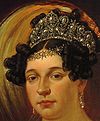 |
June 6, 1789 | September 13, 1848 | and Charles IV of Spain |
Francis I of the Two Sicilies Francis I of the Two Sicilies -Biography:Francis was born in Naples, the son of Ferdinand I of the Two Sicilies and his wife Archduchess Maria Carolina of Austria. He was also the nephew of Marie Antoinette and Louis XVI the last King and Queen of France before the first French Republic.... |
|
| 16 | Infante Francisco de Paula of Spain Infante Francisco de Paula of Spain Infante Francisco de Paula of Spain was the youngest son of Charles IV of Spain and Maria Luisa of Parma.-Marriage and children:... |
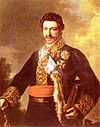 |
10 March 1794 | 13 August 1865 | and Charles IV of Spain |
Princess Luisa Carlotta of the Two Sicilies Princess Luisa Carlotta of the Two Sicilies Luisa Carlotta of Naples and Sicily , Princess the Two Sicilies, Infanta of Spain, was a daughter of King Francis I of the Two Sicilies.-Family:... |
|
Elizabeth Charlotte and Philippe : Relationship Background
Philippe's confidante, Anna GonzagaAnna Gonzaga
Anne Gonzaga was a French noblewoman and political hostess of Italian descent. She was by marriage Countess Palatine of Simmern, called "Princess Palatine", as the wife of Edward of the Palatinate, a grandson of King James I of England and an uncle of King George I of Great Britain. She bore...
, Princess Palatine, arranged his second marriage to her husband's niece, Elisabeth Charlotte
Elizabeth Charlotte of the Palatinate
Elizabeth Charlotte, Princess Palatine was a German princess and the wife of Philippe I, Duke of Orléans, younger brother of Louis XIV of France. Her vast correspondence provides a detailed account of the personalities and activities at the court of her brother-in-law, Louis XIV...
, the nineteen year old daughter of Charles I Louis, Elector Palatine
Charles I Louis, Elector Palatine
Charles Louis, , Elector Palatine KG was the second son of Frederick V of the Palatinate, the "Winter King" of Bohemia, and his wife, Princess Elizabeth, daughter of King James I of England ....
. Upon her arrival in France, "Liselotte" converted to Roman Catholicism, before the marriage ceremony.
The couple was married by proxy, in the cathedral Saint-Étienne at Metz
Metz
Metz is a city in the northeast of France located at the confluence of the Moselle and the Seille rivers.Metz is the capital of the Lorraine region and prefecture of the Moselle department. Located near the tripoint along the junction of France, Germany, and Luxembourg, Metz forms a central place...
, on 16 November 1671. The maréchal du Plessis-Praslin represented the Duke of Orléans. Philippe and Liselotte first met on the road between the towns of Châlons
Châlons-en-Champagne
Châlons-en-Champagne is a city in France. It is the capital of both the department of Marne and the region of Champagne-Ardenne, despite being only a quarter the size of the city of Reims....
and Bellay.
Whereas Philippe's first wife had been known for beauty, charm and wit, Liselotte lacked those graces. Some said that this lack explained why she fared better with her husband (who personally took charge of her toilette
Cosmetics
Cosmetics are substances used to enhance the appearance or odor of the human body. Cosmetics include skin-care creams, lotions, powders, perfumes, lipsticks, fingernail and toe nail polish, eye and facial makeup, towelettes, permanent waves, colored contact lenses, hair colors, hair sprays and...
for public occasions) than did his first wife. She bore him his only surviving son.
Liselotte also became known for her brusque candor, upright character, lack of vanity, and prolific foreign correspondence about the daily routine and frequent scandals of Versailles
Versailles
Versailles , a city renowned for its château, the Palace of Versailles, was the de facto capital of the kingdom of France for over a century, from 1682 to 1789. It is now a wealthy suburb of Paris and remains an important administrative and judicial centre...
. Her letters record how willingly she gave up sharing Philippe's bed at his request after their children's births, and how unwillingly she endured the presence of his minions in their household
Household
The household is "the basic residential unit in which economic production, consumption, inheritance, child rearing, and shelter are organized and carried out"; [the household] "may or may not be synonymous with family"....
, which caused the couple to quarrel.
But she frequently acknowledged that Philippe's treatment of her was less offensive than the impertinences his entourage indulged in at her expense, and the lack of protection he afforded her and their children against the hostile intrigues she believed were directed at her by spiteful courtiers, especially Madame de Maintenon
Françoise d'Aubigné, Marquise de Maintenon
Françoise d'Aubigné, Marquise de Maintenon was the second wife of King Louis XIV of France. She was known during her first marriage as Madame Scarron, and subsequently as Madame de Maintenon...
.
Children
| # | Name of Descendant | Portrait | Birth | Death | Relations | Marriages | Issue |
|---|---|---|---|---|---|---|---|
| 1 | Philippe II, Duke of Orléans Philippe II, Duke of Orléans Philippe d'Orléans was a member of the royal family of France and served as Regent of the Kingdom from 1715 to 1723. Born at his father's palace at Saint-Cloud, he was known from birth under the title of Duke of Chartres... |
.jpg) |
August 2, 1674 | December 2, 1723 | |
Françoise-Marie de Bourbon Françoise-Marie de Bourbon Françoise Marie de Bourbon, Légitimée de France was the youngest legitimised daughter of Louis XIV of France and his maîtresse-en-titre, Françoise-Athénaïs, marquise de Montespan. Originally known as the second Mademoiselle de Blois, that style eventually gave way to the name Françoise Marie de... |
|
| 2 | Élisabeth Charlotte, Princess of Commercy | September 13, 1676 | December 23, 1744 | |
Leopold, Duke of Lorraine Leopold, Duke of Lorraine Leopold , surnamed the Good, was Duke of Lorraine and Bar from 1690 to his death.-Early life:Leopold Joseph Charles Dominique Agapet Hyacinthe was the son of Charles V, Duke of Lorraine, and his wife Eleonora Maria Josefa of Austria, a half-sister of Leopold I, Holy Roman Emperor.At the time of... |
|
Grandchildren
| # | Name of Descendant | Portrait | Birth | Death | Relations | Marriages | Issue |
|---|---|---|---|---|---|---|---|
| 1 | Marie Louise Élisabeth d'Orléans Marie Louise Elisabeth d'Orléans Marie Louise Élisabeth d'Orléans, Duchess of Berry , was a member of the House of Orléans who married Charles, Duke of Berry.-Biography:... |
August 20, 1695 | July 21, 1719 | |
Charles de France, duc de Berry |
|
|
| 2 | Louise Adélaïde, Abbess of Chelles Louise Adélaïde d'Orléans Louise Adélaïde d'Orléans was the third daughter of Philippe d'Orléans, and Françoise Marie de Bourbon, a legitimised daughter of Louis XIV of France and his mistress, Madame de Montespan. She was Abbess of Chelles.-Biography:Marie Louise Adélaïde d'Orléans was born at the Palace of Versailles on... |
August 13, 1698 | February 10, 1743 | |
Unmarried, a nun | |
See also
- House of OrléansHouse of OrleansOrléans is the name used by several branches of the Royal House of France, all descended in the legitimate male line from the dynasty's founder, Hugh Capet. It became a tradition during France's ancien régime for the duchy of Orléans to be granted as an appanage to a younger son of the king...
- Descendants of Louis XIV of FranceDescendants of Louis XIV of FranceThe descendants of Louis XIV of France, Bourbon monarch of the Kingdom of France, are numerous. Although only three of his children by his wife Maria Theresa of Spain survived past infancy, Louis had many illegitimate children by his mistresses...
- Descendants of Henry IV of FranceDescendants of Henry IV of FranceHenry IV of France was the first Bourbon king of France. Formerly known as Henri of Navarre, he succeeded to the French throne with the extinction of House of Valois, at the death of Henry III of France. In 1584, Prince François, the youngest brother and heir presumptive of King Henry III, died...
- Descendants of Philip V of SpainDescendants of Philip V of SpainThe descendants of Philip V of Spain, Bourbon monarch of the Kingdom of Spain, Kingdom of Naples, Kingdom of Sardinia and Kingdom of Sicily are numerous. He had two wives; by his first wife Maria Luisa of Savoy he had two children. After the death of his first wife Philip married Elisabeth of Parma...

